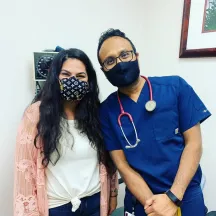Double-contrast barium enema
A double-contrast barium enema (also called DCBE or barium enema) uses X-rays to find abnormal growths in the colon. It is a form of colorectal cancer screening.
The details
- Examines the colon using X-rays
- Can detect polyps and other abnormalities in the colon
- Requires no sedation
- Is usually less expensiveoption to colonoscopy
- Uses X-rays to find abnormal growths in the colon
Barium, a silver-white metallic compound, is used to outline the colon and rectum on the X-ray. Air is then passed through the same tube to further enhance the X-ray.
DCBEs are commonly used to diagnose colorectal cancer and inflammatory disease. They can also help detect polyps, diverticulitis, and structural changes in the large intestine.

The prep
- You will need to follow a prescribed diet and bowel prep before the test.
- Like a colonoscopy, this prep commonly includes restricted intake of dairy products and a liquid diet for 24 hours beforehand.
- You’ll also need to drink lots of water or clear liquids leading up to your barium enema.
The procedure: what to expect
- You will lie on a tilting table so you can easily have X-rays taken of your abdomen.
- Next, a well-lubricated rectal tube is inserted through the anus. This tube allows your doctor to slowly administer the barium into the rectum and colon.
- Your doctor may also choose to use a rectal balloon to help keep the barium inside.
- As the barium fills the intestine, X-rays of the abdomen are taken.
- Your provider will take X-rays from several different angles to see your whole colon.
- They may also ask you to move around on the table or turn over to help spread the barium sulfate through your colon and provide additional views.
- The process lasts for about 30 to 45 minutes.

Will my insurance cover it?
Many plans cover it, socheck with your policy holder. Medicare varies, as sometimes this procedure may be substituted for a colonoscopy.
Pros & cons
Advantages
- No sedation required
- Very low risk
- Identifies lesions in the entire colon
- Accurate for finding abnormalities
- Can find cancer in earliest stage, when most treatable
- Slight risk of perforation
- Less expensive option to colonoscopy
Disadvantages
- Polyps cannot be removed during the procedure — you will need to get a colonoscopy if abnormalities are spotted on X-rays
- Requires laxative preparation
- Some may find the test uncomfortable
- Availability is decreasing; usually only for those who cannot undergo colonoscopy
- Uses X-ray radiation
- Not always covered by insurance
Who decides who pays for screening
Not sure which screening is for you?
How to talk to your doctor about screeningTop resources

Christy Williams: Biomarker testing leads to successful treatment
Statistics suggested that Christy’s odds of survival were grim, so she leaned into her faith and kept a positive outlook. She tried to control what she could. And, critically, she received biomarker testing.

EPIC Act to Advance New CRC Therapies Needs Support
The EPIC Act would encourage investment in clinical trials for additional uses of existing drugs.

Michelle Cappel: Biomarker testing extends life
Michelle Cappel owes a lot to colorectal cancer biomarker testing — seven years of life and counting.





